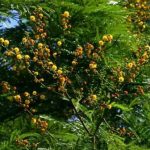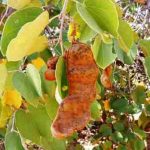TREE LIFE
August 1994
MASHONALAND CALENDAR
Saturday 6th August. Botanic Garden walk, at 10.45 for 11.00 a.m. The herbarium gates are locked during the weekends, but there will be a security guard at the public car park and this is where we will meet Tom.
Sunday 21st August. Our hosts this month are Mr. and Mrs. Cam Meredith of Twyford Farm, Chegutu. We will be particularly interested in the vegetation along the Mupfure River. It is varied with unusually large numbers of Croton megalobotrys, Kigelia africana and Diospyros mespiliformis.
Saturday 27th August. For Mark’s Botanic interest Walk this month we meet in the car park at Domboshawa Cave. Time: 3 p.m. as usual.
Tuesday 6th September. Botanic Garden Walk. NB. summertime again.
MATABELELAND CALENDAR
Sunday 7th August. To Chesa Forest with Jonathon Timberlake. This is an all day visit with rendezvous and departure from Girls’ College at the usual time of 8.30.
Sunday 4th September. To Hendrik’s Pass.
Friday 30th September. “Tree Planting Workshop” by the Rotary Club of Bulawayo at Old Falls Road Nursery at 2 p.m. Demonstrations by Mr. B. Erwee and Mr. Mlapisani.
Sunday 2nd October. A Full length video on the Rift Valley.
BOTANIC GARDEN WALK: 2 JULY 1994
Twelve members gathered, at the Gardens to hear the final part of Tom’s demonstration of the genus Rhus.
Firstly, the great Rhus/Allophylus problem was touched upon. As we all know Allophylus africanus is easily confused with those species of Rhus with toothed leaflets, such as Rhus tenuinervis.
Tom mentioned that if the plant in question has flowers, there should to no difficulty, as Allophylus flowers have 4 sepals and 4 petals, whereas Rhus have 5. Furthermore the inflorescence shape is composed of simple or branched racemes in Allophylus but is a branched panicle in Rhus. If fruits are present, these may be helpful as Allophylus fruits are ± spherical, whereas Rhus fruits are usually flattened.
If you only have leaves, Tom said that the best character is the presence of pockets of hairs in the axils of the lateral veins on the underside of the leaf. These are never present in Rhus. However, this is not a totally reliable character, as they may be difficult to detect on Allophylus leaves.
Other suggested ways of telling Allophylus from Rhus is the presence of relatively long petiolules in Allophylus (Leaflets ± unstalked in Rhus). In addition, Rhus species are said to have a characteristic smell when the leaves are crushed, which is absent in Allophylus.
In the second part of the walk, we looked at some of the trees which we may see on the visit to Penhalonga, scheduled for the Heroes’ weekend. Out of the large number we were shown, I would like to mention three.
Bridelia micrantha, Euphorbiaceae has broadly elliptical leaves with veins which re ach right to the margin and branches which may be spiny.
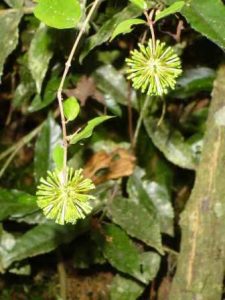
Cephalanthus natalensis. Photo: Bart Wursten. Source: Flora of Zimbabwe
Cephalanthus natalensis Rubiaceae which has very attractive flowers in small spherical heads (an unusual feature in this family which is shared by Breonadia and Burttdavya).
Chaetacme aristata Ulmaceae has zigzag stems and alternate simple leaves which usually (but not always) have a long awn at the tip.
It will be interesting to see if we manage to find these three species.
Our great thanks go to Tom once again for the help he gives to the Tree society.
-MARK HYDE
SUNDAY 3 July 1994
It had been a week of extraordinary weather. On Monday we saw the last of our Indian summer. For a fortnight it had seemed more May than June but the balmy days were swept from us ahead of an angry vest wind blowing out of Botswana which smudged Tuesday’s sky, dulled the sun and showered us with grit and dust.
By Wednesday it had swung to the south east as the first cold front thrust its way in from the Antarctic. The crystalline air and clear skies ensured frost as the wind dropped just at sunset. It was to be the worst since the sixties.
Hoses and birdbaths froze, lawn sparkled white and crunched underfoot, bougainvillea and hibiscus drooped black and dead the nest morning.
And then on Friday the next cold front poured in worse than the first and severe enough to squeeze a guti from its icy soul. It drizzled and rained on Saturday and Sunday just as it had done on the first weekend in the July of 1993, when we had also planned to visit Nata with Derek Viljoen. So like last year we again very reluctantly cancelled our visit.
Coincidence? I don’t really think so and would prefer to think of a calendar-icity or singularity. This is a tendency for “meteorological events to occur on or near specific dates .”
For instance dates which thus qualify are January 7/8, February 1 and 12 on which there is a better than average chance of getting rain.
Also in mid-May and September and on 11 March there is every prospect of a cold snap and guti. How many of us remember how frequently Rhodes and Founders was blighted with cold or Wimbledon has been watched from the fire side?
–Ian McCausland
Erene Farm 17th July 1994
While driving to the dam site, our hearts sank because the icy frosts over the last month had chilled the life out of the bush surrounding the spectacular concrete arch dam wall. In his 17 or so years in the district Christopher Bell couldn’t remember a worse winter for frost. Perhaps because of the dryness or maybe because it was an interesting area anyway, our attention was focused on items we don’t often notice, such as middens, aloes, unusual trees and frost damage.
The frost damage to the vegetation, particularly in the lower exposed areas, was startling, with the Brachystegia regrowth near the cultivated lands being hardest hit. Even with the freeze however, a handful of leaves when crushed had sufficient resilience to start unfolding when released. Acokanthera oppositifolia (bushman’s poison) suffered less, possibly due to the tough nature of the leaves or perhaps the infamous sap in the leaves freezes at a lower temperature.
It would be interesting to know more about frost and its effects on plants – some pearls of wisdom Benedicta?
Only a few colourful inflorescences of Aloe excelsa could be seen on the river banks where large numbers of these aloes grow. It was unfortunate, but drew our eyes downward, starting with an Aloe excelsa, where we noticed the distichous grey-green leaves clasping the stem and, facing each other in a regular opposite fashion. The outer surfaces of the upward curving leaves were well covered in aculeate spines – a botanical hedgehog.
The colonies of Aloe cryptopoda were, as expected, stemless and the dirty green, upward curving leaves had unusually rough surfaces – is this normal? The bracts within the striking red inflorescence were distinctive as they cover the buds with a yellow brown sheath until the flowers are sufficiently mature to face the outside world whereupon they shrivel and fall.
From frost stricken plants to a wiffy pile of poo, or rather a midden, most hygienically placed in an Antbear hole. Having earlier seen possible evidence of leopard the discovery of the midden containing Diospyros seeds and fur made us wonder if this was his territory or that of a civet. Our “Queen of civetries” confirmed later that there was no doubt that a civet was responsible.
With all these diversions we nearly forgot what we came for which was to find Fagaropsis angolensis. The large, opposite, compound leaves with a terminal leaflet had the typical citrus smell when crushed and when held to the light a thin line of gland dots were seen along the leaflet margin. Another exciting plant in the same locality was Rhamnus staddo, this time a small tree and with only a few spines was user friendly. Something I hadn’t noticed before was the often serrated margin of the alternate leaves, and the very marked presence of lenticels on the bark. Later in the day we came across a colony of Heteropyxis dehniae (lavender tree) the combinations of red and gold leaf colour and white peeling bark were most attractive.
To the Charters family, many thanks for letting us gander about the dam once again and to those who were puzzled by the lopsided sign – sorry we should have secured it.
A. MacNaughtan
THORA’S HERBAL REMEDIES
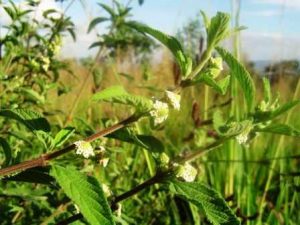
Lippia javanica. Photo: Bart Wursten. Source: Flora of Zimbabwe
Lippia javanica – this is one of the most aromatic of the indigenous shrubs and it grows all over the open veld. My gardener makes yard brooms with its stems and I often awaken to its aroma as he sweeps our crazy-paved pathways.
It is much used medicinally and in some areas is used as a perfume. It is a prized ingredient in potpourri RA’S and cupboard fresheners as it retains its pleasant scent for years. Tea, made from the leaves and flowers is very refreshing and invigorating. It is a favourite cough and cold remedy. The tea is sipped at frequent intervals and will reduce feverishness. It is also taken for malaria, measles and chest ailments. A strong lotion is dabbed on to rashes, stings and bites and is also used for scabies, head lice and scalp infections.
Some tribes inhale the smoke from the burning leaves and stems for asthma, persistent coughs and pleurisy. The crumpled leaf stuffed into the nose stops nose bleeds and clears the head. Leaves cooked in Vaseline and then strained are used to soothe strains, sprains and aching muscles. The bush is used to disinfect anthrax infected meat and to keep meat fresh for longer but this is questionable. A strong tea used in the bath is pleasantly fragrant, soothing and relaxing.
The plant is easy to grow from cuttings and seems to do well in all types of soil.
Lemon Verbena – Lippia citriadora or Aloysia triphylla. This herb which hails from Argentina and Chile is a close cousin and has the most beautiful lemon scent – the best scent in the garden. It is also lovely in the bath and potpourri. Very relaxing!
The tea made from its leaves and flowers soothe a cold and revive one after a hectic day. It can also be used to flavour cakes and chicken dishes.
Ginger Bush – Tetradenia riparia. Another of our very fragrant leaved shrubs; it is one of the easiest to propagate from cuttings. It grows in the kopjie areas of Bulawayo. The tiny pink mauve or white floors are borne in great profusion, soft and misty in appearance and are the earliest to bloom in spring. Tea is made from the leaves and is a remedy for coughs, colds and respiratory ailments. The tea is also taken for colic, stomach upsets and aches, flatulence, nausea and diarrhoea. It soothes fever, calms the patient and is good for the very old. It is a relaxing bath herb as well.
Cattle with gall sickness are treated with Iboza and (Fagara capensis) Zanthoxylum capense.
-THORA HARTLEY
VISIT TO MASALA FARM (SHAMVA) 16.6.94:
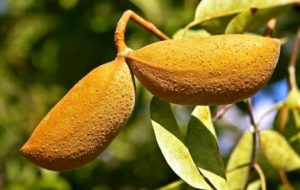
Diplorhynchus condylocarpon . Photo: Meg Coates Palgrave. Source: Flora of Zimbabwe
The visit to Masala Farm provided two features of interest, this being the vegetation on a granite rock providing an interesting ecosystem. The other was the debate concerning latex where there was a variety of opinion, observations and no fundi. The consensus of opinion was that as a group, information was scant and this was need for some basic research. It was Diplorhynchus condylocarpon (wild rubber) or mutowa in Shona and inkamanasaas in Ndebele which prompted the discussion. The tree was growing on an ant hill. The trees are fire resistant and are one of the few plants which tolerate the serpentine-derived soils of the Great Dyke.
The origins of the name are a key to identification. Diplorhynchus refers to ‘two nose’ and condylocarpon to ‘seeds that run together’ as with the South American genus Condylocarpon. The fruits are woody and are paired, curved like a horn or hooked beak at right angles to the stem. The leaves are simple elliptic and opposite and a pale yellowish green. An early Rhodesian Botanist, Fred Eyles, is said to have patched up the leaking sump of his model T Ford and was able to limp into Bulawayo. The sump would have had to have been fairly hot because this soft runny liquid latex is labile and will only undergo molecular change to form a sticky tacky rubber on heating. John Cottrill neatly cut a notch into the bark as if he had lived on a rubber plantation all his life. A stream of latex run out from between the sap wood and the bark which must have been in the phloem. The latex in this instance is acting as an anti browse. Dick Petheram recalled he had seen Diplorhynchus browsed by Kudu but only a few leaves were nibbled.
Rubber is produced by the rubber tree Hevea brasiliensis Euphorbiaceae and the latex is too plastic and inelastic for direct application. It consists principally of the cisform of polyisoprene and is converted into elastic, non plastic material by vulcanization which is treatment with sulphur.
Diplorhynchus belongs to the family Apocynaceae (the oleander family). Another example of the Apocynaceae is Carissa edulis, known as the simple spined Num-Num or Simple spined Carissa. Carissa named by Linnaeus has straight and simple spines in the species edulis. The shrub was found growing on an anthill on the slope of a hill side leading on to a stream.
Carissa edulis is grown in gardens because it has beautiful white sweet-scented jasmine-like flowers. It is a shrub with a tendency to scramble. The fruit is ovoid to almost spherical turning purplish black when mature and is edible (Num-Num). Beware, be warned the fruit and the parts of the tree are easily confused with the deadly poisonous genus Acokanthera which are distinguished by being unarmed i.e. no thorns. The Bushmen used the poison from the fruit of the tree for their arrows. The bark and wood are used today by indigenous people as an arrow poison. The poison is a tar-like substance derived from boiling chips of wood and bark.
(Coates Palgrave writes about the reality of the toxicity of Acokanthera where experimentation has shown injection of the poison into a healthy animal causes death almost immediately and humans infected with an arrow wound die within 30 minutes to two hours.) Acokanthera oppositifolia (the common poison bush) also seen on this excursion should be treated with respect. Meat grilled over a fire kindled with sticks from Acokanthera causes death. Similarly, the common garden oleander, Nerium oleander should not be used for braai vleis wood. The garden Oleander is exotic and occurs in Israel/Palestine. The brook is often referred to in the Old Testament and was obviously a very important source of water and the ephemeral nature of a dried up brook is found In Job (6.15). Sometimes a stream¬bed had a mantle of vegetation owing to its shallow water table. The “brook of willow” (Isaiah 15,7) describes the cover of oleander bushes and other vegetation which were Poplars and not the weeping willows.
The Boney-M are incorrect when they say the children of Israel hung the harps on the weeping willow tree (Salix babylonica) when they remembered Zion. The weeping willow probably originates in Iran and China.
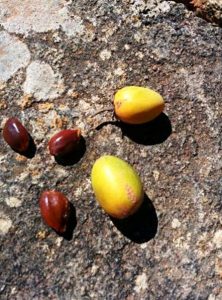
Mimusops zeyheri. Photo: Mark Hyde. Source: Flora of Zimbabwe
Two latex bearers which enjoy “wet feet” were along the river towards the brick workings and these belong to the family Sapotaceae and are the milk plum Bequaertiodendron magalismontanum named after the Belgian Botanist, Bequaert and was Bequaert’s tree (Dendron) and has now become Engles phyton (plant), (Englerophyton) Englerophytum. The other tree was Mimusops zeyheri the common red milk wood, muchechete (Shona) or umbumbulu (Ndebele).
The figs of the family Moraceae, genus Ficus contain a milky sap; Figs are distinguished by their swollen receptacles is the well known Candelabra tree. The latex is very potent causing irritation and blistering to skin, permanent blindness. Cattle driven through the trees have been so badly burnt on the lips, head and eyes that they have to be destroyed. In the Limpopo Valley, the latex is soaked up in a bundle of grass and tied to a stone and thrown into the water where it brings the fish to the surface paralysed but still breathing.
The warmth of the sun and the brightly coloured aloes on the large granite rock was attractive. On walking up the hill to the rock, aloes and Senna were encountered, the Senna just opening into its first cluster of beautiful yellow flowers. Aloes and Cassia are mentioned by name in Psalm (45.8) “their garments smell of aloes and cassia”. The perfume used for garments and beds was a precious spice derived from the modern Eagle-wood (Aquilaria agallochun). Planned seduction on a bed of aloes would have been a thorny predicament. Two species of aloes were identified. Aloe chabaudii is described by Reynolds as the most widely distributed aloes found at the foot of granite Whalebacks and outcrops. The plants are small, growing in clusters forming suckers from the base with grey-green leaves having a narrow cartilaginous edge armed with small deltoid teeth. The leaves are unspotted. The inflorescence is loose and arranged like a pyramid. Aloe chabaudii growing in the shade had dark green softer leaves, longer stems and fewer flowers which were much darker in colour. Aloe greatheadii which is normally single, grows in grass and is fire resistant. The leaves are usually wrinkled and withered at the end and bear numerous white spots on the upper surface; the lower surface of the leaf is pale to grey without spotting. The leaves have a horny brown border. The inflorescences are long about 1.5 m standing above the surrounding grass. The flowers are flesh pink with a white stripe to the base. The sprawling Euphorbia griseola over the rock surface was recognizable by its four sided stems.
At the look edges was fine grey Selaginella dregei and numerous other dried up ferns peeping out from under rooks and crevices. The long succulent thick leafless grey-brown sticks of Sarcostemma jutted above the granite surface growing out from what might have been an excuse for a small pocket of soil. A small green carpet of Leptactina was growing in shallow soil next to the rocks.
There were a wide variety of brown, greys and crackling twigs, leaves and grasses waiting dormant for the rains. It was a pity there was not enough time to explore this ecosystem under the excellent guidance of Mark Hyde.
The trees are somewhat stunted, especially the Albizia antunesiana given away by a few purplish leaflets with light undersides. The leaflets are opposite as were the pinnae. The Mobola plum, Parinari curatellifolia was full of mustard coloured buds and growing in the grass besides rocks. The fruit is part of the staple diet of the local people. The wood contains silica crystals and is difficult to saw. A well developed tree is beautiful and in May 1873 a Chitambi village in Zambia an inscription was carved in such tree as a tribute to Dr. Livingstone.
The Faurea was thought to be Faurea speciosa. Sharing the grassland next to these rocks was a small much-branched Tarenna neurophylla with its pale green leaves.
The conversation veered to Euphorbia wildii and the peculiar flora of the Great Dyke, which probably could be the topic of another interesting visit.
-Mary Toet
NATIONAL TREE PLANTING DAY
Would any of our members like to become involved in a tree-planting project to mark ‘National Tree Planting Day’? It has been suggested that something positive be undertaken, like, for example, encouraging the planting of trees at a rural school and maintaining interest by follow-up visits to the school. Members’ participation and ideas would be welcome. It is intended that a subcommittee will be set up. If you have the time and interest and would like to volunteer please write to us at P 0 Box 2128, Harare. We already have an offer of seedlings and help with transport.
ANDY MACNAUGHTAN CHAIRMAN


